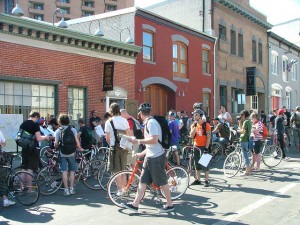Quick Hits
Build Downtown Baltimore Bicycle Network.
Why: Cities around the world like Copenhagen, Amsterdam, New York, and even our neighbor Washington, D.C. have shown that the best way to get more people riding bicycles for everyday transportation needs is to create physically separated on- road paths. Generally, this involves taking a section of road that had been used for moving or parked cars and reallocating it for bicycle use only; the physical separation can be achieved in many ways — either by constructing a second concrete curb between the bicycle and auto lanes (e.g. Fallsway), or by simply removing one travel lane, moving the parking one lane over, and using the row of parked cars as a barrier (e.g. 15th Street in Washington, D.C.).
Traffic separation is key to enhancing the actual and perceived safety of bicycling in Baltimore. Today, downtown Baltimore lacks a good north/south bicycle path through the center of the City. The Maryland Avenue Cycletrack (following Maryland Avenue, Cathedral Street, Liberty Street, and Hopkins Place between 29th Street in Charles Village to Pratt Street downtown) will link Charles Village to the Inner Harbor and points between, including MICA and University of Baltimore, eventually connecting to the Gywnns Falls and Jones Falls Trails.
Not all Baltimore roads are wide enough to accommodate present auto traffic levels, street parking, and physically separated bicycle lanes. For those that are wide enough, like Maryland Avenue (which turns into Cathedral Street, Liberty Street, and Hopkins Place as it goes south), our plan is to create a network of world-class bicycle paths that people of all ages and abilities will feel comfortable using for their daily transportation needs — all without inordinately affecting auto and truck traffic.
Jones Falls Trail Improvements.
Why: The Trail is nearly complete, and is close to being a tremendous asset, but there are some small but important problems that BCDOT and BCRP need to address to improve safety, visibility, and wayfinding. These small investments will maximize the trail’s return on investment.
BCDOT staff educated on bicycle planning and engineering.
Why: Recent months have seen the departures of several BCDOT staffers who had a lot of experience with bicycle- and pedestrian-friendly engineering. BCDOT currently does not have the staffing necessary to design the next wave of bicycle infrastructure to be built after the Downtown Bike Network is complete. We encourage BCDOT not only to hire a new Bicycle & Pedestrian Planner within a reasonable timeframe, but also to prioritize knowledge of bike/ped engineering principles for all new hires going forward.
Enhance public access to transportation planning and resurfacing documents and data.
Why: Presently, Bikemore and other advocates are not sufficiently included in the process of designing our City’s roads. Advocates are forced to ask BCDOT staffers to review engineering and planning documents for road design projects — documents that should by rights be free and open to the public. We ask that BCDOT post all past, present, and future public meeting, planning, and engineering documents on the City’s Open Data site for public review.
More bike racks and corrals and web-based bicycle rack requests.
Why: As the popularity of bicycling has grown, the City’s supply of public bicycle racks has proven inadequate for demand. We ask that the City create a user-friendly online system for citizens, business owners, and other stakeholders to request City- installed bicycle racks, and to make their supply of racks available ASAP.
Establish and support bikeshare.
Why: Bike Share could change the face of biking in Baltimore. The aforementioned bicycle infrastructure will be a tremendous asset to people who already ride their own bicycles, and to people who are “interested but concerned” about bicycling, but it will also be extremely important to the success of Baltimore’s forthcoming Bikeshare system. The two items go hand-in-hand: Good bicycle infrastructure is crucial to Bikeshare’s success, especially because many of its users will be tourists and other people who do not ride bicycles regularly in Baltimore.
Work Group Members
[table]
Name,Affiliation
“Liz Cornish, Chair“, Bikemore
Scott Burkholder,Baltimore Museum of Art
Elizabeth Gordon,Kittelson & Assoc.
Mike Kaurich,
Jeff LaNoue,University of Baltimore
Maura Mahoney,Zipcar
Chris Merriam,Zipcar
Luke Mowbray,University of Maryland
Anikwenze Ogbue, McCormick Taylor
Wally Pinkard,World Trade Center Institute
Jeremy Pomp,Zipcar
Ben Stone,Station North
[/table]
Most Recent Bike Meetings
View all Bike Meetings.
